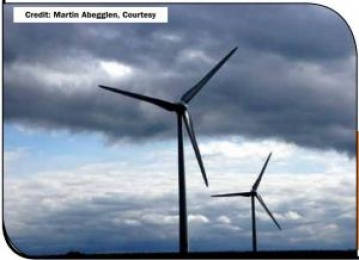
Dear Earth Talk: What is the latest prognosis for wind energy to command a larger piece of the renewable energy pie?
Hydroelectric sources of power dwarf other forms of renewable energy, but wind power has been a dominant second for years, and continues to show “hockey stick” growth moving forward. According to the Global Wind Energy Council (GWEC), global cumulative installed wind capacity—the total amount of wind power available—has grown fifty-fold in less than two decades, from just 6,100 megawatts (MW) in 1996 to 318,137 MW in 2013. And the future looks brighter still. Analysts from Bloomberg New Energy Finance (BNEF) predict that wind will account for the largest share—30 percent—of new renewables added to the global power grid by 2030. That new renewables are expected to account for as much as 70 percent of all new power sources over the next 20 years means that wind is poised to become a major player on the global energy scene. Here in the U.S., energy generated by domestic wind farms has nearly tripled in just the past four years, despite a brief hiccup due to a lapse in the Production Tax Credit, a renewable energy production incentive that effectively subsidizes the creation of more wind farms. But even despite this, wind represented about a third of all new power added to the U.S. grid over the past five years. The Natural Resources Defense Council (NRDC), a leading environmental non-profit and wind power advocate, forecasts that the U.S. will derive some 20 percent of its total electricity production from wind by 2030.
Here in the U.S., energy generated by domestic wind farms has nearly tripled in just the past four years andrepresents about a third of all new power added to the U.S. grid over the past five years.“The
U.S. industry has many reasons for favorable long-term prospects,”
reports the American Wind Energy Association (AWEA), a nonprofit trade
group representing the wind industry. “In addition to the record
activity at the end of 2013, wind energy helped keep the lights on and
insulate against temporary price spikes during the recent ‘polar
vortex’cold weather snap,
demonstrating the value of wind power in a balanced energy portfolio.”
AWEA also points out recent reports showing how
incorporation of wind energy lowers costs for electric consumers. “And
critical to some parts of the country facing continuing drought, wind
energy uses no water in its production, as well as releasing no
emissions,” adds the group.
The
fact that wind energy in the U.S. avoids some 100 million tons of
carbon dioxide emissions annually is also good news. AWEA adds that that
number will grow as wind energy scales up to 20 percent of the grid and
beyond “making the addition of more wind power one of the fastest,
cheapest, and largest-scale ways for states to meet the Administration’s
new goals for reducing carbon pollution from power plants.”
While wind continues to grow fast, solar may finally be catching up. According to BNEF, some 36.7 gigawatts (GW) of new solar photovoltaic capacity were added worldwide in 2013 compared with 35.5 GW worth of new wind power installations. BNEF adds that global demand for wind turbines may actually shrink in 2014 (by five percent), representing the first such decline since 2004. But Justin Wu, head of wind analysis for BNEF, says it’s just a temporary blip: “Falling technology costs, new markets and the growth of the offshore industry will ensure wind remains a leading renewable energy technology.”
CONTACTS:
BNEF, about.bnef.com; NRDC, www.nrdc.org;
AWEA, www.awea.org.EarthTalk® is written and edited by Roddy Scheer and Doug Moss and is a registered trademark of E - The Environmental Magazine (www.emagazine.com). Send questions to: earthtalk@emagazine.com.
























